|

Introduction
Acer leapt back in to the mainstream monitor
market around this time last year with the release of some exciting new gaming
screens. They haven't looked back since. Their Predator series has garnered a
lot of attention with innovative technology developments for gamers. If we think
back to Feb 2015 we tested the world's first 144Hz IPS panel in the
Acer XB270HU. Since then we've also reviewed their ultra-wide 34" gaming
screens, the FreeSync capable
XR341CK and G-sync capable
X34. Acer were the first to start pushing the refresh rate as well, with
overclocking supported from the monitor itself, offering impressive performance
from what are currently some modestly spec'ed panels. For instance, their X34
pushed a normal 60Hz IPS panel from LG.Display successfully up to 100Hz. They
also pushed the boundaries of their 35" ultra-wide screen, the
Z35, where it's native 144Hz VA panel could be overclocked to 200Hz!
We've got with us now one of Acer's other new
gaming screens. The XB271HK (not to be confused with the recently released
XB271HU) is a 27" sized screen with an Ultra HD 3840 x 2160 resolution ("4k")
IPS-type panel for a high pixel density and super-sharp image. It's a 60Hz panel
given current bandwidth limitations of DisplayPort connections but they have
paired it with NVIDIA G-sync technology to help users run a high resolution
screen for gaming. It carries the same zero-frame styling as some of their other
new models as well. We hope to see Acer continue to push the boundaries for
gaming displays and remain a solid player in this space for years to come. Let's
see how the XB271HK performs in our tests.
If you appreciate the review
and enjoy reading and like our work, we would welcome a
donation
to the site to help us continue to make quality and detailed reviews for you.
|
Check Pricing and Buy - Direct Links
|
|
Amazon USA |
Amazon UK |
Overclockers UK |
Amazon GER |
Amazon CAN
|
|
TFTCentral is a participant
in the Amazon Services LLC Associates Programme, an affiliate
advertising programme designed to provide a means for sites to earn
advertising fees by advertising and linking to Amazon.com, Amazon.co.uk,
Amazon.de, Amazon.ca and other Amazon stores worldwide. We also
participate in a similar scheme for Overclockers.co.uk. |

Specifications and Features
The following table gives detailed information
about the specs of the screen:
|
Monitor
Specifications |
|
Size |
27"WS (69 cm) |
Panel Coating |
Light AG coating |
|
Aspect Ratio |
16:9 |
Interfaces |
1x DisplayPort 1.2a
1x HDMI 1.4
|
|
Resolution |
3840 x 2160 |
|
Pixel Pitch |
0.1552 mm |
Design
colour |
Matte black bezel and stand with some maroon
trim |
|
Response Time |
4ms G2G |
Ergonomics |
Tilt, 150mm height, rotate, swivel |
|
Static Contrast Ratio |
1000:1 |
|
Dynamic Contrast Ratio |
100M :1 |
VESA Compatible |
Yes 100mm |
|
Brightness |
300 cd/m2 |
Accessories |
Power, DisplayPort and USB cables |
|
Viewing Angles |
178 / 178 |
|
Panel Technology |
AU Optronics AHVA (IPS-type) |
Weight |
Net
7.0Kg |
|
Backlight Technology |
W-LED |
Physical Dimensions |
(WxHxD) with stand:
614.0 x 401.4 - 551.4 x 268.4 mm |
|
Colour Depth |
1.07b (10-bit) |
|
Refresh Rate |
60Hz |
Special
Features |
4x
USB 3.0 ports, audio out, 2x 2W speakers, NVIDIA G-sync |
|
Colour Gamut |
Standard gamut
~sRGB, ~72% NTSC |
The XB271HK offers a limited range of connectivity
options given the use of a G-sync module. However, these have improved since the
early G-sync capable screens released which only featured a single DisplayPort interface.
This model offers DP 1.2a and an additional HDMI 1.4 input as well which is
useful. The digital interfaces are HDCP certified for encrypted content and the
video cables are provided in the box for DisplayPort only, along with a USB
cable.
The screen has an internal power supply with the power cable you need
in the box. There are also 4x USB 3.0 ports,
2 located on the back of the screen next to the video and power
connections and 2 easy-access ports on the left hand side. There are also 2x 2W
stereo speakers and an audio
out connection offered but no further extras like card readers, ambient light sensors or human motion sensors
provided as those are more aimed at office uses, while this is primarily a
gaming screen.
Below is a summary of the features and connections
of the screen:
|
Feature |
Yes / No |
Feature |
Yes / No |
|
Tilt adjust |
 |
DVI |
 |
|
Height adjust |
 |
HDMI |
 |
|
Swivel adjust |
 |
D-sub |
 |
|
Rotate adjust |
 |
DisplayPort |
 |
|
VESA compliant |
 |
Component |
 |
|
USB 2.0 Ports |
 |
Composite |
 |
|
USB 3.0 Ports |
 |
Audio connection |
 |
|
Card Reader |
 |
HDCP Support |
 |
|
Ambient Light Sensor |
 |
MHL Support |
 |
|
Human Motion Sensor |
 |
Integrated Speakers |
 |
|
Touch Screen |
 |
PiP / PbP |
 |
|
Factory Calibration |
 |
Blur Reduction Mode |
 |
|
Hardware calibration |
 |
G-Sync |
 |
|
Uniformity correction |
 |
FreeSync |
 |

Design and Ergonomics

The XB271HK comes in a mostly black design, with
matte plastics used for the bezel, stand and base. Those who disliked the
glossy plastics of the XB270HU model last year will be pleased with the
shift to matte plastics. There is some maroon-red trim in places, most
visible on the feet of the stand. This looks a little more orange in the
press photos above, but you will see a truer idea of the colour from our
photos below. There is a silver predator logo in the middle of the lower
bezel, but no further writing on the front of the screen.
The bezel measures 22mm thickness along the
bottom edge. On the sides and top though the screen is a frame-less
design, with a 2mm plastic border around those sides. There is also a 6mm
panel border so a total of ~8mm along the sides and top before the image
starts.
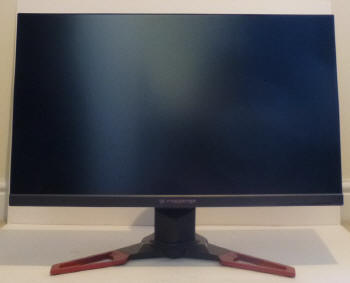 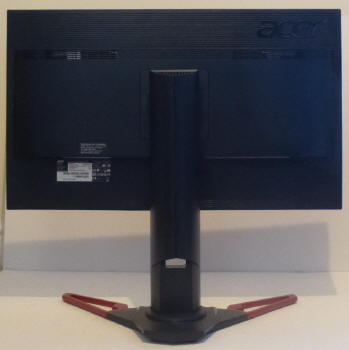
Above: front
and back views of the screen. Click for larger versions
The back of the screen is finished in a matte
black plastic as well. There is an Acer logo in the top right hand corner
(as viewed from behind) and some air grills to help with heat dissipation.
The stand attaches in the middle at the back but can be quickly and easily
removed using a quick release button. The screen can then be arm- or
wall-mounted as it is VESA 100 compliant.
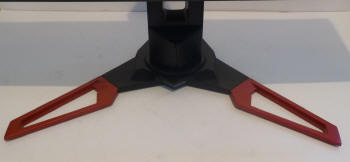
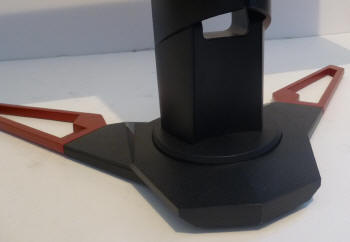
Above: views of
the base of the stand and cable tidy hole
The stand provides a wide and sturdy base for the
screen ensuring very little wobble from the screen. There is some maroon-red trim on the feet as you can see above to
provide some contrasting colour to all the black plastics. At the back of
the base of the stand is a cable tidy hole as well.
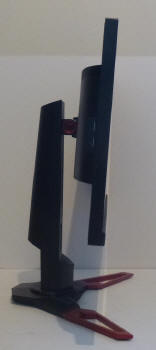
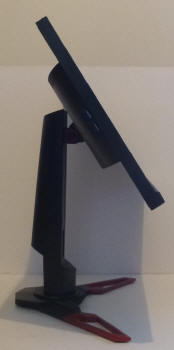
Above: full
tilt adjustment range shown and side profile
From the side, the screen itself is pretty
thin thanks to the use of a W-LED backlighting unit. The stand is fairly
chunky though, but does at least provide some strong support. The tilt
adjustment offers a good range of adjustment as shown above and this is
smooth and easy to move.
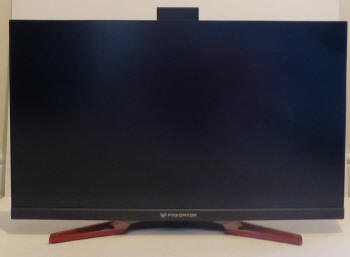
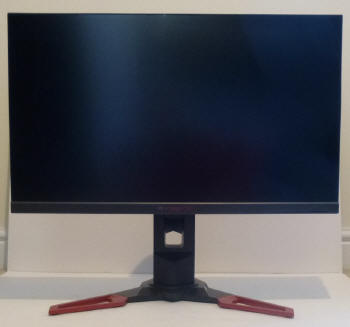
Above: full
height adjustment range show
The height adjustment again provides a very good
range and is again smooth and easy to manoeuvre. At the lowest setting the
bottom edge of the screen is ~30mm from the top of the desk, while at
maximum extension it is ~180mm. This gives a decent 150mm adjustment range
as per the spec.
Side to side swivel is also offered and it's
nice and easy to re-position the screen. Even the rotation to portrait is
nice and easy to use. Acer have done a nice job with this stand, it's
flexible, easy to use and smooth.
A summary of the screens ergonomic adjustments
is shown below:
|
Function |
Range |
Smoothness |
Ease of Use |
|
Tilt |
Yes |
Smooth |
Easy |
|
Height |
150mm |
Smooth |
Easy |
|
Swivel |
Yes |
Smooth |
Easy |
|
Rotate |
Yes |
Smooth |
Fairly easy |
|
Overall |
Full range of adjustments
offered, smooth and easy to use |
The materials were of a good standard and the
build quality felt good as well. We liked the new thin bezel design and the
move to matte plastics will probably be popular with most buyers. There was no
audible noise from the screen, even when using specific test images which
sometimes induce buzzing. The screen also remained cool even during prolonged
use thanks to the W-LED backlight unit.

Above:
interface connections on the back of the screen
The back of the screen provides the
video connections as shown above. There are only DisplayPort 1.2a and HDMI 1.4
inputs on this model given the use of NVIDIA G-sync. With it being a G-sync V
II module, HDMI is at least provided to give you some further flexibility
which is nice. Only the DP can support G-sync
though. On the back there is also the power connection (not shown here),
headphone connection, USB upstream and 2x USB 3.0 downstream.
In the middle is a service port by the way.
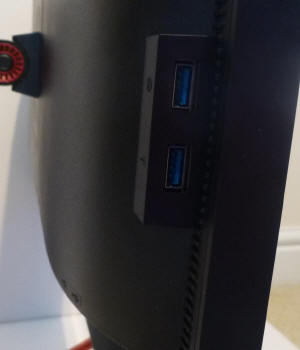
Above: side USB
ports
On the left hand edge of the screen are two easy
access USB 3.0 ports. Useful to have these more readily
available in this location we thought, even with the thin design of the
screen.

OSD Menu

Above: OSD control buttons on the bottom edge of the screen. Click for
larger version
The OSD menu is accessed and controlled through 5
pressable buttons located on the front of the bottom right hand corner of the screen, along
with a power button. Between the power button and the right most menu button is
the power LED. This glows a bright blue during normal operation and amber in
standby.

Pressing any of the buttons pops up a small quick
launch menu where you can get quick access to the game modes, overdrive control,
volume control and input selection. You can of course access the main menu as well.
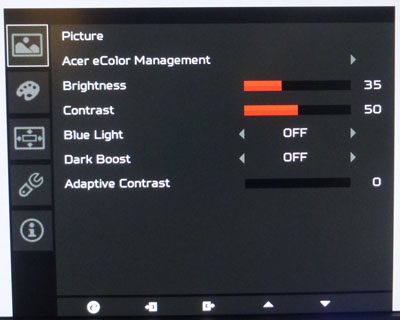
The main menu is split in to 5 sections down the
left hand side, with the options available in each shown on the right hand side.
The 'picture' menu contains a lot of general controls as shown above. You can
operate the low blue light modes here, or switch between the eColor presets -
which are basically a set of pre-defined brightness/contrast levels.
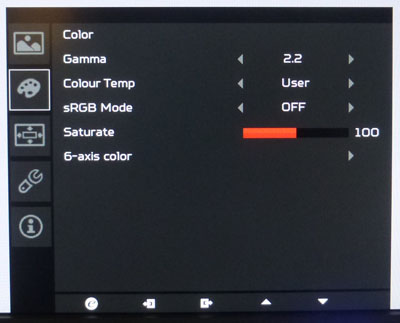
The 'color' menu has control over the gamma and
colour temp here, useful for
calibration.
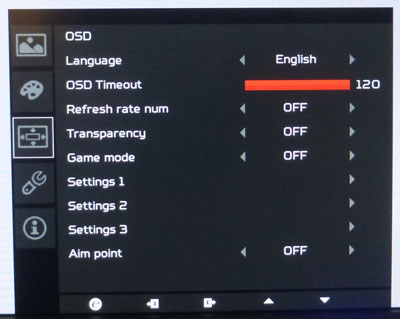
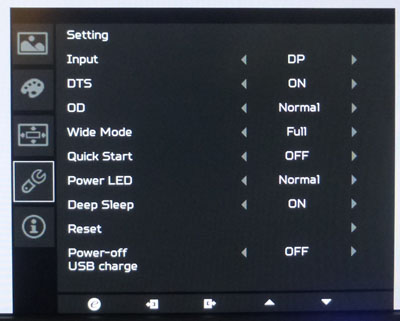
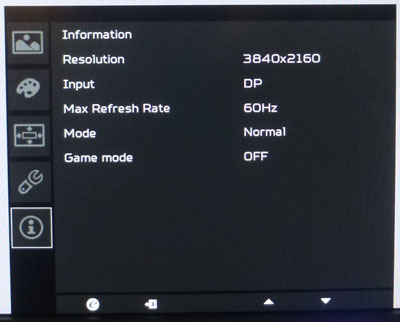
The other 3 sections are shown above and are
pretty self explanatory. Navigation was easy enough and fairly intuitive,
although sometimes you did have to drill in to several levels to get to the
option you wanted.

Power Consumption
In terms of power consumption the manufacturer
lists a power on usage of 71.5W, and 0.42W in standby. We carried out our normal tests to
establish its power consumption ourselves.
|
 |
|
State and Brightness
Setting |
Manufacturer Spec (W) |
Measured Power Usage
(W) |
|
Default (80%) |
71.5 |
54.9 |
|
Calibrated (35%) |
- |
38.5 |
|
Maximum Brightness (100%) |
- |
62.2 |
|
Minimum Brightness (0%) |
- |
28.1 |
|
Standby |
0.42 |
0.5 |
|
We tested this ourselves and found that out of the
box the screen used 54.9W at the default 80% brightness setting. Once calibrated
the screen reached 38.5W consumption, and in standby it used only 0.5W. We have
plotted these results below compared with other screens we have tested.


Panel and Backlighting
|
Panel Manufacturer |
AU Optronics |
Colour Palette |
1.07 billion |
|
Panel Technology |
AHVA (IPS-type) |
Colour Depth |
10-bit |
|
Panel Module |
M270QAN01.1 |
Colour space |
Standard gamut |
|
Backlighting Type |
W-LED |
Colour space coverage (%) |
~sRGB, ~72% NTSC |
Panel Part and Colour Depth
The Acer XB271HK features an
AU Optronics M270QAN01.1 AHVA (IPS-type) panel which is capable of producing 1.07
billion colours. This is achieved with a true 10-bit colour depth as opposed to
using any Frame Rate Control methods, according to the panel spec sheet. Keep in
mind whether this is practically useable and whether you're ever going to
truly use that colour depth. You need to have a full 10-bit end to end
workflow to take advantage of it which is still quite expensive to achieve and
rare in the market, certainly for your average user. This includes relevant
applications and graphics cards as well, so to many people this 10-bit support
might be irrelevant.
We want to try and ensure there's no confusion
between AHVA and IPS as well at this juncture. AHVA (Advanced Hyper Viewing
Angle) is a relatively new technology developed by AU Optronics, not to be
confused with their more long-standing technology AMVA (Advanced
Multi-Domain Vertical Alignment). It is AU Optronics' answer to LG.Display's
very popular, and long-established IPS (In Plane Switching) technology. Testing
of this technology has revealed that it is for all intents and purposes the same
as IPS. Performance characteristics, features and specs are all pretty much
identical. AUO weren't allowed to simply call their technology IPS due to
trademark issues, which is why they adopted their own new name. Samsung are the
same with their PLS (Plane to Line Switching) panel tech, which is another
IPS-clone. You will see pretty much all monitor manufacturers now simply use the
term IPS, since it is so well known in the market, but underneath they may be
using an IPS version from LG.Display, AU Optronics or Samsung potentially.
People should not get concerned with the semantics here, which is why we will
continually refer to this as an "IPS-type" panel throughout the review.
The part is confirmed when dismantling the screen:
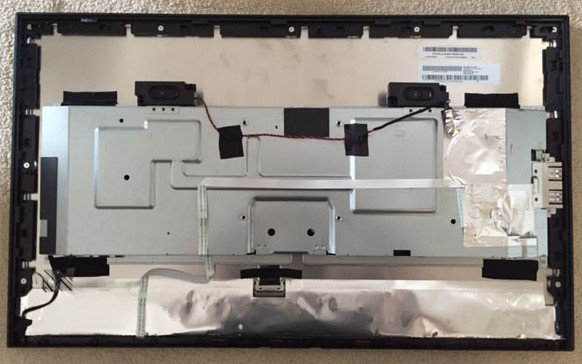

Screen
Coating
The
screen coating is a light anti-glare (AG) offering. It isn't a semi-glossy
coating, but it is light as seen on other modern IPS type panels. Thankfully it
isn't a heavily grainy coating like some old IPS panels feature and is also
lighter than modern TN Film panel coating. It retains its anti-glare properties
to avoid too many unwanted reflections of a full glossy coating, but does not
produce an too grainy or dirty an image that some thicker AG coatings can. There
were some very slight cross-hatching patterns visible on the coating if you
looked very closely, but nothing to the extent of what some people find
problematic on the U2713HM model.
Backlight Type and Colour Gamut
The screen uses a White-LED (W-LED) backlight unit
which is standard in today's market. This helps reduce power consumption
compared with older CCFL backlight units and brings about some environmental
benefits as well. The W-LED unit offers a standard colour gamut which is
approximately equal to the sRGB colour space. Anyone wanting to work with wider
colour spaces would need to consider wide gamut CCFL screens or the newer range
of GB-r-LED type (and similar) displays available now. If you want to read more
about colour spaces and gamut then please have a read of our
detailed article.
Backlight
Dimming and Flicker
We tested the screen to establish the methods used
to control backlight dimming. Our in depth article talks in more details about a
common method used for this which is called
Pulse Width Modulation (PWM). This in itself gives cause for concern to some
users who have experienced eye strain, headaches and other symptoms as a result
of the flickering backlight caused by this technology. We use a photosensor +
oscilloscope system to measure backlight dimming control
with a high level of accuracy and ease. These tests allow us to establish
1) Whether PWM is being used to control the
backlight
2) The frequency and other characteristics at which this operates, if it is used
3) Whether a flicker may be introduced or potentially noticeable at certain
settings
If PWM is used for backlight dimming, the higher
the frequency, the less likely you are to see artefacts and flicker. The duty
cycle (the time for which the backlight is on) is also important and the shorter
the duty cycle, the more potential there is that you may see flicker. The other
factor which can influence flicker is the amplitude of the PWM, measuring the
difference in brightness output between the 'on' and 'off' states. Please
remember that not every user would notice a flicker from a backlight using PWM,
but it is something to be wary of. It is also a hard thing to quantify as it is
very subjective when talking about whether a user may or may not experience the
side effects.
100% 50%
0%



Above scale = 1
horizontal grid = 1ms
At 100% brightness a constant voltage is applied
to the backlight. As you reduce the brightness setting to dim the backlight a
Direct Current (DC) method is used, as opposed to any form of PWM. This applies
to all brightness settings from 100% down to 0%. The screen is flicker free as a
result, as advertised.
|
Pulse Width
Modulation Used |
No |
|
Cycling
Frequency |
n/a |
|
Possible
Flicker at |
|
|
100% Brightness |
No |
|
50% Brightness |
No |
|
0% Brightness |
No |
For an up to date list of all flicker-free (PWM free) monitors please see our
Flicker Free Monitor Database.

Contrast
Stability and Brightness
We wanted to see how much variance there was in
the screens contrast as we adjusted the monitor setting for brightness.
In theory, brightness and contrast are two independent parameters, and good
contrast is a requirement regardless of the brightness adjustment.
Unfortunately, such is not always the case in practice. We recorded the
screens luminance and black depth at various OSD brightness settings, and
calculated the contrast ratio from there. Graphics card settings were left at
default with no ICC profile or calibration active. Tests were made using an
X-rite i1 Display Pro colorimeter. It should be noted that we used the
BasICColor calibration software here to record these, and so luminance at
default settings may vary a little from the LaCie Blue Eye Pro report.
|
OSD
Brightness |
Luminance
(cd/m2) |
Black
Point (cd/m2) |
Contrast
Ratio
( x:1) |
|
100 |
263.85 |
0.26 |
1015 |
|
90 |
243.47 |
0.24 |
1014 |
|
80 |
223.13 |
0.22 |
1014 |
|
70 |
202.36 |
0.20 |
1012 |
|
60 |
180.79 |
0.18 |
1004 |
|
50 |
158.54 |
0.16 |
991 |
|
40 |
135.51 |
0.13 |
1042 |
|
30 |
111.45 |
0.11 |
1013 |
|
20 |
86.41 |
0.09 |
960 |
|
10 |
60.31 |
0.06 |
1005 |
|
0 |
33.06 |
0.03 |
1102 |
|
Total Luminance Adjustment Range
(cd/m2) |
230.79 |
Brightness OSD setting controls backlight? |
 |
|
Total Black Point
Adjustment Range (cd/m2) |
0.23 |
|
Average Static Contrast Ratio |
1016:1 |
PWM Free? |
 |
|
Recommended OSD setting
for 120 cd/m2 |
33 |
The brightness control gave us a very good range
of adjustment. At the top end the maximum luminance reached 264
cd/m2 which was
a little shy of the specified maximum brightness of 300 cd/m2 from
the manufacturer. There was a decent 231 cd/m2 adjustment range in
total, and so at the minimum setting you could reach down to a low luminance of
33 cd/m2. This should be adequate for most people wanting to work in
darkened room conditions with low ambient light. A setting of 33 in the OSD menu should return you a
luminance of around 120 cd/m2 at default settings.
It should be noted that the
brightness regulation is controlled without the need for
Pulse Width Modulation, using a Direct Current (DC) method for all
brightness settings between 100 and 0% and so the screen is flicker free as
advertised.

We have plotted the
luminance trend on the graph above. The screen behaves as it should in this
regard, with a reduction in the luminance output of the screen controlled by the
reduction in the OSD brightness setting. This is pretty much a linear relationship as you
can see.

The average contrast ratio of
the screen was very good for an IPS-type panel with an average of 1016:1. This was mostly
stable across the brightness adjustment range as shown above although it did
seem to go a bit higher at 20% brightness and less.

Testing
Methodology
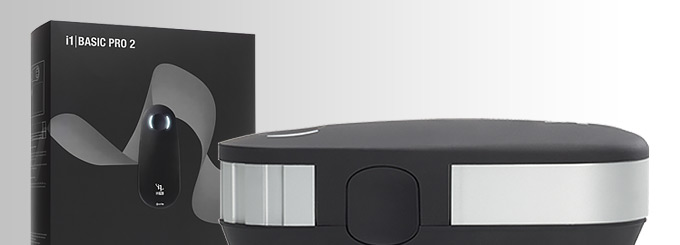
An
important thing to consider for most users is how a screen will perform out of
the box and with some basic manual adjustments. Since most users won't have
access to hardware colorimeter tools, it is important to understand how the
screen is going to perform in terms of colour accuracy for the average user.
We restored our graphics card to default settings
and disabled any previously active ICC profiles and gamma corrections. The
screen was tested at default factory settings using our new
X-rite i1
Pro 2 Spectrophotometer combined with
LaCie's Blue Eye Pro software suite. An X-rite i1 Display Pro colorimeter was
also used to verify the black point and contrast ratio since the i1 Pro 2
spectrophotometer is less
reliable at the darker end.
Targets for these tests are as follows:
-
CIE Diagram - validates the colour space
covered by the monitors backlighting in a 2D view, with the black triangle representing the
displays gamut, and other reference colour spaces shown for comparison
-
Gamma - we aim for 2.2 which is the default
for computer monitors
-
Colour temperature / white point - we aim
for 6500k which is the temperature of daylight
-
Luminance - we aim for 120
cd/m2, which is
the recommended luminance for LCD monitors in normal lighting conditions
-
Black depth - we aim
for as low as possible to maximise shadow detail and to offer us the best
contrast ratio
-
Contrast ratio - we aim
for as high as possible. Any dynamic contrast ratio controls are turned off here
if present
-
dE average / maximum -
as low as possible.
If DeltaE >3, the color displayed is significantly different from the
theoretical one, meaning that the difference will be perceptible to the
viewer.
If DeltaE <2, LaCie considers the calibration a success; there remains a
slight difference, but it is barely undetectable.
If DeltaE < 1, the color fidelity is excellent.

Default Performance and
Setup
Default settings of the screen were as follows:
|
Monitor OSD Option |
Default Settings |
|
Preset mode (eColor) |
Standard |
|
Brightness |
80 |
|
Contrast |
50 |
|
RGB |
n/a |
|
Gamma |
2.2 |
|
Colour Temp |
Warm |

Acer XB271HK - Default Settings





|
|
Default Settings |
|
luminance (cd/m2) |
237 |
|
Black Point (cd/m2) |
0.23 |
|
Contrast Ratio |
1014:1 |
Initially out of the box the screen was set in the
default 'standard' eColor preset mode. You could tell the screen was using a
standard gamut backlight and the image looked good to the naked eye, but too bright for
comfortable use with the default brightness set at 80%. Colour balance felt pretty good
as well, if perhaps slightly too warm. We went ahead and measured the default state with
the i1 Pro 2.
The
CIE diagram on the left of the image confirms that the monitors colour gamut
(black triangle) is roughly equal to
the sRGB colour space. There is some over-coverage in some shades, particularly
in blues and greens where it extends a little beyond the sRGB reference. Default
gamma was very good with a 2.2 average measured, and only a small 2% deviance. White point was
a little off from the target, being measured at 6125k (a little too warm)
and so a little off the 6500k target, but still with a low 6% deviance. The
screen was set in the default 'standard' colour temp mode incidentally with RGB
not available to tweak unless you enter the 'user' mode which we will do later for
calibration.
Luminance was recorded at a very bright 237
cd/m2 which is
too high for prolonged general use. The screen was set at a default 80%
brightness in the OSD menu but that is easy to change of course to reach a more
comfortable setting without impacting any other aspect of the setup. The black
depth was 0.23 cd/m2 at this default
brightness setting, giving us a very good static contrast ratio (for an IPS-type panel) of
1014:1.
Colour accuracy was excellent with an average dE
of only 1.2 and maximum of 2.7.
Testing the screen
with colour gradients revealed smooth gradients with only some very minor gradation
evident in darker tones. Overall default setup was very good and you only really
need to carry out some minor adjustment to the brightness and colour temperature
which is easy enough through some basic adjustments as shown in the next
section.

Calibration
We used the
X-rite i1
Pro 2 Spectrophotometer combined with the LaCie Blue Eye Pro
software package to achieve these results and reports. An X-rite i1 Display Pro
colorimeter was used to validate the black depth and contrast
ratios due to lower end limitations of the i1 Pro device.
|
Monitor OSD Option |
Default Settings |
|
Preset mode |
User |
|
Brightness |
35 |
|
Contrast |
50 |
|
RGB |
96, 96, 100 |
|
Gamma |
2.2 |
|
Colour temp |
User |

Acer XB271HK - Calibrated Settings


|
|
Calibrated Settings |
|
luminance (cd/m2) |
120 |
|
Black Point (cd/m2) |
0.13 |
|
Contrast Ratio |
943:1 |
If you make any changes to the OSD you are
automatically moved in to the 'user' eColor mode. To get access to the RGB
channels you need to change the colour temp setting to 'user', and then you can
drill in to that section further to change those settings directly. All the OSD
changes listed in the table above allowed us to obtain an
optimum hardware starting point and setup before software level changes would be
made at the graphics card level. We left the LaCie software to calibrate
to "max" brightness which would just retain the luminance of whatever brightness
we'd set the screen to, and would not in any way try and alter the luminance at
the graphics card level, which can reduce contrast ratio. These adjustments
before profiling the screen would help preserve tonal values and limit
banding issues as much as possible. After this we let the software carry out the LUT adjustments and create an
ICC profile.
The minor 2% deviance in gamma out of the box had
been corrected here through the profiling process. The white point was now
corrected nicely thanks to the RGB adjustments, being measured at 6500k spot on
(0% deviance) and correcting the small 6% deviance we had out of the box.
Luminance had been improved thanks to the adjustment to the brightness control
and was now being measured at 120
cd/m2. This
left us a black depth of 0.13 cd/m2 and maintained a good static contrast ratio
(for an IPS-type panel) of
943:1. Colour accuracy of the resulting
profile was very good, with dE average of 0.4 now.
Testing the screen with colour gradients revealed
smooth gradients with only some minor gradation evident in darker tones as you
see from most screens. There was no banding evident thankfully.
You can use our settings and
try our calibrated ICC profile if you wish, which are available in
our ICC profile database. Keep in mind that results will vary from one
screen to another and from one computer / graphics card to another.

Calibration Performance Comparisons

The comparisons made in this section try to give
you a better view of how each screen performs, particularly out of the box which
is what is going to matter to most consumers. When comparing the default factory
settings for each monitor it is important to take into account several
measurement areas - gamma, white point and colour accuracy. There's no point
having a low dE colour accuracy figure if the gamma curve is way off for
instance. A good factory calibration requires all 3 to be well set up. We have
deliberately not included luminance in this comparison since this is normally
far too high by default on every screen. However, that is very easily controlled
through the brightness setting (on most screens) and should not impact the other
areas being measured anyway. It is easy enough to obtain a suitable luminance
for your working conditions and individual preferences, but a reliable factory
setup in gamma, white point and colour accuracy is important and not as easy to
change accurately without a calibration tool.
From these comparisons we can also compare the
calibrated colour accuracy, black depth and contrast ratio. After a calibration
the gamma, white point and luminance should all be at their desired targets.

Default setup of the screen out of the box was
very good really. There was a decent gamma curve, low dE and strong contrast
ratio for an IPS-type panel. The only thing which really needed correcting
(other than the normal brightness adjustment to suit) was the white point, which
thankfully is nice and easy to correct through basic OSD adjustments and was
only slightly out to start with anyway. The
IPS-type panel delivers stable and reliable images without obvious contrast and
colour tone shift that you see from other gaming screens based on TN Film
panels.


The display was good for an IPS-type panel when
it came to black depth and contrast ratio. With a calibrated contrast ratio
of 943:1 it was comparable to some of the other gaming IPS-type screens we've tested,
like the
Acer XB270HU (1000:1) and
Asus ROG Swift PG279Q (989:1). It was not quite as high as some modern IPS-type panels like the
Dell U2515H
(1138:1) for instance. Of course none of these IPS screens can compete with VA panel types
which can reach over 2000:1 easily, and
even close to 5000:1 in the case of the 24"
Eizo FG2421 shown here.
|
Check Pricing and Buy - Direct Links
|
|
Amazon USA |
Amazon UK |
Overclockers UK |
Amazon GER |
Amazon CAN
|
|
TFTCentral is a participant
in the Amazon Services LLC Associates Programme, an affiliate
advertising programme designed to provide a means for sites to earn
advertising fees by advertising and linking to Amazon.com, Amazon.co.uk,
Amazon.de, Amazon.ca and other Amazon stores worldwide. We also
participate in a similar scheme for Overclockers.co.uk. |

Viewing Angles
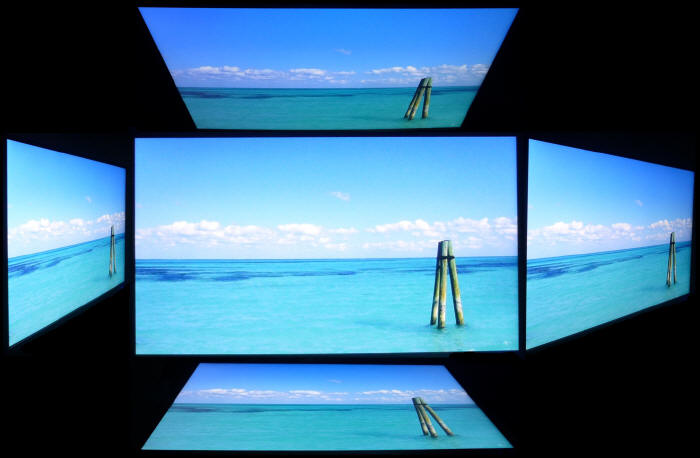
Above: Viewing
angles shown from front and side, and from above and below. Click for
larger image
Viewing angles of the screen were very good as you
would expect from an IPS panel. Horizontally there was very little colour tone
shift until wide angles past about 45°. A slight darkening of the image occurred
horizontally from wider angles as you can see above as the contrast shifted
slighting. Contrast shifts were slightly more noticeable in the vertical field
but overall they were very good. There was some slight pink tone introduced from
wide vertical angles. The screen offered the wide viewing angles of IPS
technology and was free from the restrictive fields of view of TN Film panels,
especially in the vertical plane. It was also free of the off-centre contrast
shift you see from VA panels and a lot of the quite obvious gamma and colour
tone shift you see from some of the modern VA panel type offerings. All as
expected really from a modern IPS panel.
This is one of the big positives of using IPS
panel technology as opposed to the common TN Film matrices which are generally
adopted in gaming displays. If you compare the viewing angles to the
TN Film based Asus ROG Swift PG278Q for example you can see the obvious
differences, especially vertically. Some people argue it won't matter if you're
just viewing the screen head on anyway and that's true to a point. However, even
if you are viewing it head on, as you glance to the sides, or particularly as
you glance up or down vertically, there are subtle colour tone and contrast
shifts caused by the pixel alignment on the TN Film panel. This isn't really a
problem for general uses and gaming, but if you were doing any colour critical
work or photo editing it is not ideal. The IPS panel of the XB271HK shows a far
more stable image thanks to the differing panel technology, and does not suffer
from these viewing angle issues. This is also important should you want to use
the screen for gaming from a distance, where your viewing position may vary
more, or where you may have additional players who can't view the screen as head
on as you. Likewise for movie viewing the changing angles of view can be
problematic on a TN Film panel. Those issues are not as much of a problem on the
IPS panel of the XB271HK.
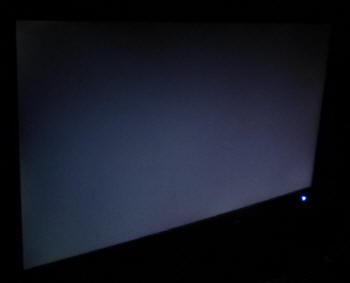
Above: View of an
all black screen from the side. Click for larger version
On a black image there is a characteristic white
glow when viewed from an angle, commonly referred to as "IPS-glow". This is
common on most modern IPS-type panels and can be distracting to some users. The
level of glow here is the same as other recent gaming IPS panels we've seen like
the Acer XB270HU and Asus MG279Q and is pretty typical of a modern IPS-type
panel. If you view dark content from a normal head-on viewing position, you can
actually see this glow slightly as your eyes look towards the edges of the
screen. Some people may find this problematic if they are working with a lot of
dark content or solid colour patterns. In normal day to day uses, office work,
movies and games you couldn't really notice this unless you were viewing darker
content. If you move your viewing position back, which is probably likely for
movies and games, the effect reduces as you do not have such an angle from your
eye position to the screen edges.
This is one area where the TN Film panel of some
other gaming displays is better, as there is
far less pale glow (Asus ROG Swift PG278Q example again) from an angle on
dark content. For dark room conditions, and a lot of dark content some people
might prefer to live with the more restrictive viewing angles and less glow of
the TN Film panel. Others might want to use the screen for more all-round uses
and prefer the IPS panel. It's down to preference really and your individual
uses.

Panel Uniformity
We wanted to test
here how uniform the brightness was across the screen, as well as identify any
leakage from the backlight in dark lighting conditions. Measurements of the luminance
were taken at 35 points across the panel on a pure
white background. The measurements for luminance were taken using BasICColor's calibration
software package, combined with an X-rite i1 Display Pro
colorimeter with a central point on the screen calibrated to 120 cd/m2. The below uniformity diagram shows the difference, as a percentage,
between the measurement recorded at each point on the screen, as compared with the
central reference point.
It is worth
noting that panel uniformity can vary from one screen to another, and can depend
on manufacturing lines, screen transport and other local factors. This is only a
guide of the uniformity of the sample screen we have for review.

Uniformity of Luminance

The luminance uniformity of the screen was
reasonably good
although
showed some variance around the edges, particularly on the right and left
hand sides. Luminance dropped to 98 cd/m2 in the most extreme
case (-22.45% deviance, bottom left hand area) but most of the edges were
around 10 - 15% deviance from the centrally calibrated point of 120 cd/m2.
Overall, about half of the screen was within a 10% variance from this
reference point.

Backlight Leakage
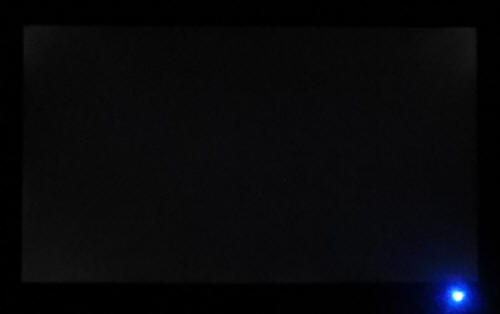
Above: All black screen in a darkened room. Click for larger version
As usual we also tested the screen with an all
black image and in a darkened room. A camera was used to capture the result. The
camera showed there was some clouding detected from the four corners, although
it was not too severe.
Note: if you want to test your own screen for
backlight bleed and uniformity problems at any point you need to ensure you have
suitable testing conditions. Set the monitor to a sensible day to day brightness
level, preferably as close to 120
cd/m2
as you can get it (our tests are once the screen is calibrated to this
luminance). Don't just take a photo at the default brightness which is almost
always far too high and not a realistic usage condition. You need to take the
photo from about 1.5 - 2m back to avoid capturing viewing angle characteristics,
especially on IPS-type panels where off-angle glow can come in to play easily.
Photos should be taken in a darkened room at a shutter speed which captures what
you see reliably and doesn't over-expose the image. A shutter speed of 1/8
second will probably be suitable for this.

General and Office Applications
The XB271HK feature a massive 3840 x 2160 Ultra HD
resolution, all packed in to a 27" sized screen. The higher resolution is not
about providing more screen real-estate here and we need to move away from
thinking about LCD resolution in that manner. In fact it is arguable that the
wide range of 2560 x 1440 resolution panels in the 27" sector are about as high
a resolution as you want to go, without making fonts and icons too small
natively. That provides a pretty comfortable option to work with day to day.
Here, with the resolution being so much higher it
is about providing a sharper and crisper image, while still operating with a
similar desktop area and similar font size to the 1440p models. It is providing
a higher pixel density (Pixels Per Inch, PPI) to improve the degree of
definition to the image. You need to us operating system scaling to handle this
properly. If you try and run the screen without any scaling at 3840 x 2160 the
0.156mm pixel pitch makes everything far too small and tiny. In our view you
need a screen of about 39 - 40" in size (like the
Philips BDM4065UC) to use an Ultra HD or 4K resolution effectively without
OS scaling. On this 27" model, if you increase the scaling to 150%, you actually
end up with the same workspace area as 2560 x 1440, but at a much higher PPI
pixel density - and therefore a sharper image. Have a read of
Eizo's very useful article for some more information on the whole matter.
For those wanting a high pixel density for CAD, design, photo work etc, this is
a really good option. The image was very sharp and crisp and text was very
clear.
Keep in mind that not all Operating Systems and
applications handle scaling the same. More recent versions of Windows (8.1 and
10) tend to handle it all better, and recent versions of Mac OS are pretty solid
as well. Some applications and games don't handle scaling correctly and so you
can end up with some things with very minute text and fonts and some things
which don't scale completely in every place. Keep this in mind if you're
selecting any super high resolution display as it could be an important factor.
You need to ensure you have the necessary operating system and applications to
handle scaling effectively for your needs.
You do need to keep in mind the need for a
compatible graphics card with a suitable output which can handle this
resolution, and preferably at 60Hz refresh rate. DisplayPort and HDMI 2.0 are
the only options to run the screen at its native 3840 x 2160 res at 60Hz, so in
the absence of HDMI v2.0 here you will need to use DisplayPort. When running at
native resolution this model is recognised as a single display which makes life
easier than some of the early MultiStream (MST) models. It's also good to see
support for 60Hz refresh rate as some 4k models only offer 30Hz support which is
very limiting, even in day to day uses (certainly for gaming!).
The light AG coating of the panel is welcome, and
much better than the grainy and 'dirty' appearance of older IPS AG coatings. The
wide viewing
angles provided by this panel technology on both horizontal and vertical planes,
helps minimize on-screen colour shift when viewed from different angles.
The
default setup of the screen was decent as well, offering an accurate gamma
curve, decent contrast ratio and low dE. The brightness range of the screen was
also very good, with the ability to offer a luminance between 264 and 33 cd/m2.
This should mean the screen is perfectly useable in a wide variety of ambient
light conditions, including darkened rooms. A setting of ~33 in the OSD
brightness control should return you a luminance close to 120 cd/m2
out of the box. On another positive note, the brightness regulation is
controlled without the need for the use of the now infamous
Pulse-Width Modulation (PWM), and so those who suffer from eye fatigue or
headaches associated with flickering backlights need not worry. There was no
audible noise or buzzing from the screen, even when specifically looking for it
using test images with a large amount of text at once. The screen also remains
cool even during prolonged use.
The screen offers 4x USB 3.0 ports (with charging
capabilities also) which is very handy. 2 are on the left hand edge of the
screen for easy access. There aren't any other extras like card readers or
ambient light sensors offered though. The stand offers a wide range of
adjustments which is great news, allowing you to obtain comfortable viewing
positions easily.

Responsiveness and Gaming
|
Quoted G2G Response Time |
4ms G2G |
|
Quoted ISO Response Time |
n/a |
|
Panel Manufacturer and
Technology |
AU Optronics AHVA (IPS-type) |
|
Panel Part |
M270QAN01.1 |
|
Overdrive Used |
Yes |
|
Overdrive Control Available to
User |
OD |
|
Overdrive Settings |
Off, Normal, Extreme |
The XB271HK is rated by Acer as having a 4ms G2G response time, which indicates the panel uses
overdrive /
response time compensation (RTC) technology to boost pixel transitions
across grey to grey changes. There is user control over the overdrive impulse
within the OSD menu using the 'OD' option. The
part
being used is the
AU Optronics M270QAN01.1 AHVA (IPS-type) panel. Have a read about response time in
our
specs section if you need additional information about this measurement.
We will first test the screen using our thorough
response time testing method. This uses an oscilloscope and photosensor to
measure the pixel response times across a series of different transitions, in
the full range from 0 (black) to 255 (white). This will give us a realistic view
of how the monitor performs in real life, as opposed to being reliant only on a
manufacturers spec. We can work out the response times for changing between many
different shades, calculate the maximum, minimum and average grey
to grey (G2G) response times, and provide an evaluation of any overshoot present
on the monitor.
We use an
ETC M526
oscilloscope for these measurements along with a custom photosensor device.
Have a read of
our response time measurement article for a full explanation of the testing methodology and reported
data.
Response Time Setting Comparison
The XB271HK comes with a user control for the
overdrive impulse available within the OSD menu in the 'setting' section as well
as via one of the quick launch menu buttons. There are
3 options available here under the
'OD' setting (OD = Overdrive). First of all we carried out a fairly small set
of measurements and motion tests in both settings for the purposes of
identifying which was the optimum response time setting, over DisplayPort and at
the maximum 60Hz refresh rate.

Firstly we tested the response times with the
setting off. Response times were pretty slow, particularly on grey to grey
transitions. An average of 11ms G2G was measured here which was moderate for an
IPS panel to be fair. Given there was no overdrive being applied, there was no
overshoot at all in this mode.

With OD turned up to the middle 'normal' setting,
we saw an improvement in response times. Average response times were now a
decent 7.7ms G2G and with the very low levels of overshoot, this made it one of
the fastest IPS-type panels we've tested actually at 60Hz. There were
improvements in perceived motion clarity as well with a less pronounced blurring
to moving images. Overshoot remained at a low level which was not evident in
practice.

Perhaps predictably the highest 'extreme' setting
was too aggressive. The response times had been improved down to 6.1ms G2G
average, but the overshoot was now significant. You could see dark and pale
trails in moving objects although to be honest they weren't overly distracting
in most cases. The overshoot wasn't at some of the crazy levels we've seen from
other aggressive overdrive controls on other screens. We still preferred the
overshoot-free 'normal' mode though and would recommend sticking with that.

More Detailed Measurements
Response Time setting = Normal
Having established that the normal OD setting
offered the best response/overshoot balance we carried out our normal wider
range of measurements as shown below.
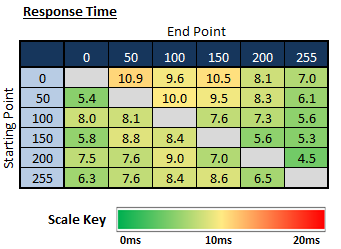 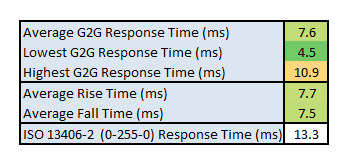
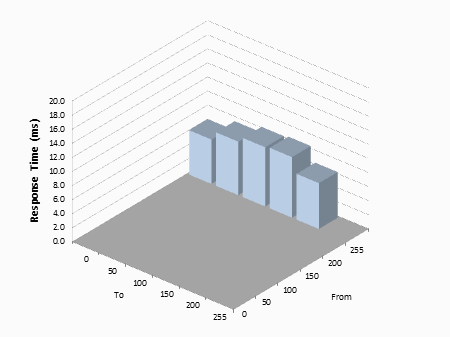
The average G2G response time was more accurately
measured at 7.6ms which was excellent for an IPS-type panel at 60Hz.
Transitions were pretty stable across all the changes, whether they were changes
from dark to light (rise times) or from light to dark (fall times). Some transitions did reach down to
close to the specified 4ms G2G although a few were a bit slower at up to around
11ms.
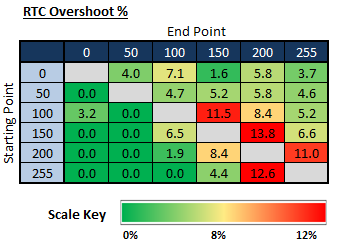
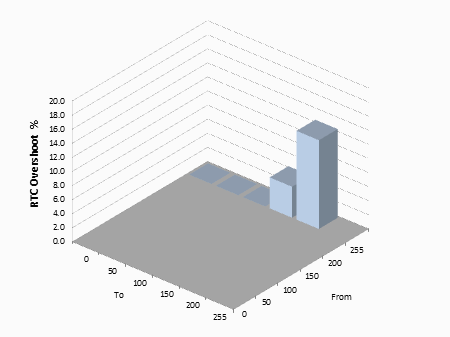
There was some moderate levels of overshoot at
this setting on a few transitions, but not any huge amounts. Most transitions
showed little to no overshoot at all which was very pleasing, especially given
the response times had clearly been pushed down to a low level for a 60Hz
IPS-type panel. A decent result here.

Display Comparisons
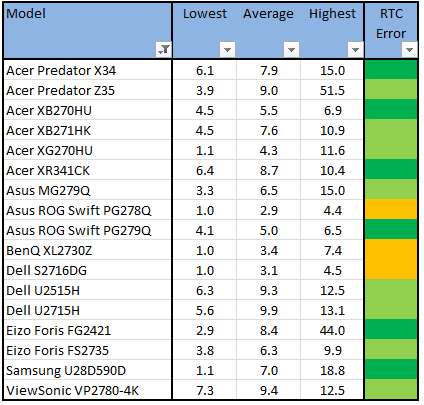
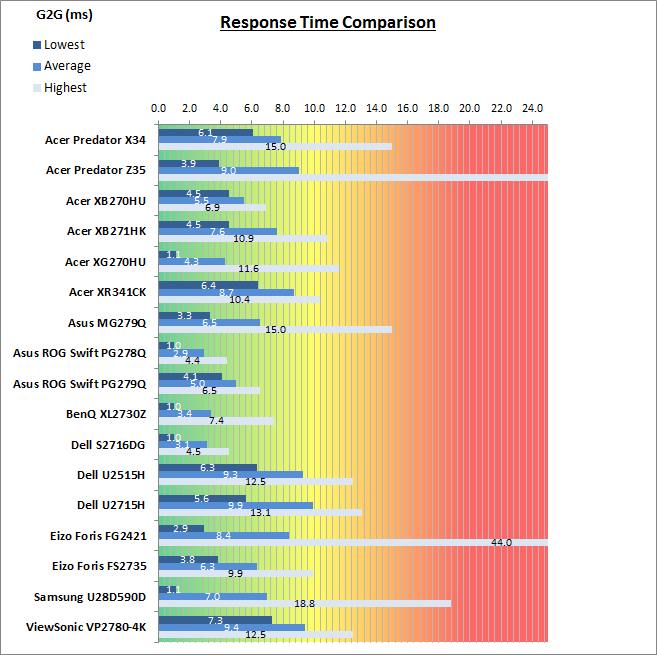
The above comparison table and graph shows you the
lowest, average and highest G2G response time measurement for each screen we
have tested with our oscilloscope system. There is also a colour coded mark next
to each screen in the table to indicate the RTC overshoot error, as the response
time figure alone doesn't tell the whole story.
Overall the responsiveness of the XB271HK was very
good for an IPS-type panel. It can't offer the fluidity and frame rates of a
high refresh rate panel of course, but for a 60Hz IPS panel it was excellent.
With a 7.6ms G2G average, and pretty low levels of overshoot it represented
about as good as you could hope for from a 60Hz panel of this technology. Around
8.5ms G2G is the best we've seen with zero overshoot, so Acer had pushed this a
little further. A small amount of overshoot had been introduced as a side effect
but we felt it was at a low enough level that it didn't become distracting or
noticeable in practice. The high refresh rate IPS panels like the Acer XB270HU,
XB271HU and Asus ROG Swift PG279Q for instance can offer a step up though in
terms of gaming experience. Their response times are pushed even lower at the
higher refresh rates up to 144Hz, and combined with the higher refresh rate
provide a smoother and more fluid gaming experience. You get the benefits of
higher frame rates in FPS games on those high refresh rate models.
The benefit of the XB271HK though to some users
will be the higher UltraHD resolution (3840 x 2160), pushing beyond the 2560 x
1440 res of those high refresh rate offerings. It provides a sharp and detailed
image and many users love the "4k" gaming experience. Images look sharp and
crisp even up close. One
big consideration you need to make is that the 3840 x 2160 @ 60Hz resolution is
likely to be a major drag on even high end graphics cards and PC systems when it
comes to gaming. You really need to think about the type of game you want to
play, the settings you want to use, and whether your system can handle
outputting such a high resolution effectively. Thankfully the addition of NVIDIA
G-sync allows for dynamic control over the refresh rate up to 60Hz, helping to
eliminate tearing and stuttering and avoiding the need to use the lag-inducing
V-sync option. So even those systems that can't manage the 3840 x 2160 @ 60Hz
reliably should be better on a screen like this with variable refresh rate.
Your graphics card will also need to support
DisplayPort 1.2 and preferably be an NVIDIA G-sync capable card given that's a
big part of this screen (and cost). Other interfaces including the HDMI 1.4
inputs are limited to 30Hz at 3840 x 2160. Don't forget that many gaming titles
don't support this 4k resolution either, so that could be another issue. Some
games don't handle scaling very well and so when it comes to the user interface
a lack of scaling results in tiny text or hard to read maps etc. Be wary of that
as well as the game needs to handle scaling properly on a screen this size. One
option of course is to run the game at a lower resolution and let the screen
scale it. That's probably the most sensible option in most cases. It does kind
of defeat the point of having a 4k resolution in the first place though. If you
have games which can natively support this resolution properly, they would look
fantastic given the very high resolution and high pixel density. External games
consoles running at 1080p will still look ok, and the image is interpolated
quite well.
The screen was also tested using the chase test in
PixPerAn for the following display comparisons. As a reminder, a series of
pictures are taken on the highest shutter speed and compared, with the best case
example shown on the left, and worst case example on the right. This should only
be used as a rough guide to comparative responsiveness but is handy for a
comparison between different screens and technologies as well as a means to
compare those screens we tested before the introduction of our oscilloscope
method.

27"
4ms
G2G AU Optronics AHVA (IPS-type) @ 60Hz (OD = Normal)
In practice the Acer XB271HK performed best with
the OD response time setting at normal. There were low levels of blurring evident, the image looked sharp
and there was no noticeable overshoot detected. The screen lacked the fluidity
and smoothness of a high refresh rate panel, but for a 60Hz IPS screen it was
impressive. The additional G-sync support for NVIDIA users will also be of real
benefit especially considering the system demands of the high Ultra HD
resolution.

27"
4ms
G2G AU Optronics AHVA (IPS-type) @ 60Hz (OD = Normal)

27"
4ms
G2G AU Optronics AHVA (IPS-type) @ 144Hz (OD = Normal)

27"
4ms G2G AU Optronics AHVA (IPS-type)
@ 144Hz (OD = Normal)

27"
4ms
G2G AU Optronics AHVA (IPS-type) @ 144Hz (Trace Free = 80)

27"
4ms G2G AU Optronics AHVA (IPS-type)
@ 144Hz (overdrive = enhanced)
The above images compare the XB271HK then with the
four high refresh rate IPS-type panels we've tested. In practice the high
refresh rate IPS models show smooth and fluid movement and are also free of any
noticeable overshoot as well which is pleasing. We know that those other screens
have a slightly faster response time on the most part, but it's the higher
refresh rate which really brings about the main benefits in gaming and perceived
motion clarity, making them more suited to gaming than the XB271HK. That's not
to say that the XB271HK is bad, it's not, it's just that it can't keep up with
the high refresh rate panels which is logical anyway.

27"
4ms
G2G AU Optronics AHVA (IPS-type) @ 60Hz (OD = Normal)

27"
1ms
G2G AU Optronics TN Film @ 144Hz (Response Time = Normal)

27"
1ms
G2G AU Optronics TN Film @ 144Hz (OD = Normal)

27"
1ms
G2G AU Optronics TN Film @ 144Hz (AMA = High)
The above then compares the XB271HK with a few
popular TN Film based gaming models, all with 2560 x 1440 resolution and 144Hz
refresh rate. The TN Film models shown here are faster in terms of measured
response times, and again their high refresh rate brings about obvious
improvements in motion performance. There are moderate levels of overshoot on
each of them though as a result of the aggressive overdrive impulse, with some
dark trailing becoming noticeable in certain cases. TN Film panels also have a
different "feel" than the IPS models in terms of snappiness and speed. Obviously
these TN Film gaming screens offer a better overall gaming experience for
various reasons than the XB271HK, but you are of course sacrificing in some of
the all-round performance benefits of the XB271HK's IPS panel. You also miss out
on the Ultra HD high resolution on those other panels, which after all is one of
the key selling points of this Acer screen.

Additional Gaming Features
1) Preset modes
- There is a no specific 'game' mode available in the OSD eColor menu,
so if you wanted something different for your gaming uses you might want to
try one of the other modes, which have preset brightness levels.
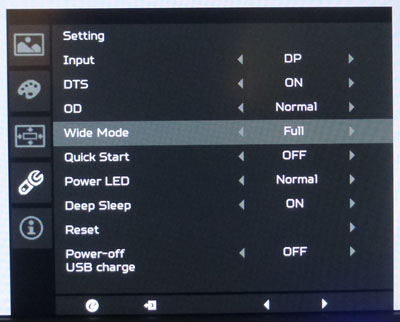
4) Aspect
Ratio Control - The screen has 3 options for
aspect ratio control through the OSD 'setting' menu as shown above.
There are options for full, aspect and 1:1 pixel mapping. Nice to see an
automatic aspect ratio option available which will maintain the source input
aspect ratio and scale to fill as much of the screen as possible. Also great
to see a 1:1 pixel mapping mode.

Lag
We have written an in depth article about
input lag and the various measurement techniques which are used to evaluate
this aspect of a display. It's important to first of all understand the
different methods available and also what this lag means to you as an end-user.
Input Lag vs. Display Lag vs. Signal
Processing
To avoid confusion with different terminology we
will refer to this section of our reviews as just "lag" from now on, as there
are a few different aspects to consider, and different interpretations of the
term "input lag". We will consider the following points here as much as
possible. The overall "display lag" is the first, that being the delay between
the image being shown on the TFT display and that being shown on a CRT. This is
what many people will know as input lag and originally was the measure made to
explain why the image is a little behind when using a CRT. The older stopwatch
based methods were the common way to measure this in the past, but through
advanced studies have been shown to be quite inaccurate. As a result, more
advanced tools like SMTT provide a method to measure that delay between a TFT
and CRT while removing the inaccuracies of older stopwatch methods.
In reality that lag / delay is caused by a
combination of two things - the signal processing delay caused by the TFT
electronics / scaler, and the response time of the pixels themselves. Most
"input lag" measurements over the years have always been based on the overall
display lag (signal processing + response time) and indeed the SMTT tool is
based on this visual difference between a CRT and TFT and so measures the
overall display lag. In practice the signal processing is the element which
gives the feel of lag to the user, and the response time of course can
impact blurring, and overall image quality in moving scenes. As people become
more aware of lag as a possible issue, we are of course keen to try and
understand the split between the two as much as possible to give a complete
picture.
The signal processing element within that is quite
hard to identify without extremely high end equipment and very complicated
methods. In fact the studies by Thomas Thiemann which really kicked this whole
thing off were based on equipment worth >100,1000 Euro, requiring extremely high
bandwidths and very complicated methods to trigger the correct behaviour and
accurately measure the signal processing on its own. Other techniques which are
being used since are not conducted by Thomas (he is a freelance writer) or based
on this equipment or technique, and may also be subject to other errors or
inaccuracies based on our conversations with him since. It's very hard as a
result to produce a technique which will measure just the signal processing on
its own unfortunately. Many measurement techniques are also not explained and so
it is important to try and get a picture from various sources if possible to
make an informed judgement about a display overall.
For our tests we will continue to use the SMTT
tool to measure the overall "display lag". From there we can use our
oscilloscope system to measure the response time across a wide range of grey to
grey (G2G) transitions as recorded in our
response time
tests. Since SMTT will not include the full response time within its
measurements, after speaking with Thomas further about the situation we will
subtract half of the average G2G response time from the total display lag. This should allow us to give a good estimation of
how much of the overall lag is attributable to the signal processing element on
its own.
Lag Classification
To help in this section we will also introduce a broader classification system
for these results to help categorise each screen as one of the following levels:
-
Class 1)
Less than 16ms / 1 frame lag at 60Hz - should be fine for gamers, even at high levels
-
Class
2)
A lag of 16 -
32ms / One to two frames of lag at 60Hz - moderate lag but should be fine for many gamers.
Caution advised for serious gaming and FPS
-
Class
3)
A lag of more
than 32ms / more than 2 frames of lag at 60Hz - Some noticeable lag in daily usage, not
suitable for high end gaming
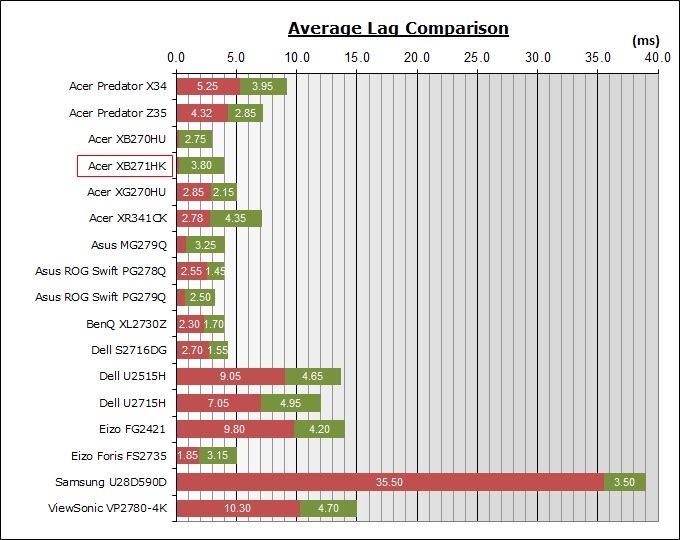
For the full reviews of the models compared here and the dates they were written
(and when screens were approximately released to the market), please see our
full
reviews index.
|
(Measurements in ms) |
|
|
Total Display Lag (SMTT
2) |
4.00 |
|
Pixel Response Time
Element |
3.80 |
|
Estimated Signal
Processing Lag |
0.20 |
|
Lag Classification |
1 |
|

Class 1 |
We have provided a comparison above against other
models we have tested to give an indication between screens. The screens
tested are split into two measurements which are
based on our overall display lag tests (using SMTT) and half the average G2G
response time, as measured by the oscilloscope. The response time is split from
the overall display lag and shown on the graph as the green bar. From there, the
signal processing (red bar) can be provided as a good estimation.
The screen showed a total lag of only 4.00ms.
Approximately 3.80ms of that can be accounted for by pixel response times,
leaving an estimated signal processing lag of only 0.20ms. This is basically
nothing and means the screen should be fine for all levels of gaming. Other
G-sync screens to date have shown similar very low levels of lag which is
pleasing.

Movies and Video

The following summarises the screens performance
in video applications:
-
27"
screen size makes it a reasonable option for an all-in-one multimedia screen,
much smaller than LCD TV's and many larger format desktop monitors which are
now emerging.
-
16:9
aspect ratio is well suited to videos and movies, leaving
you with smaller/no borders on DVD's and wide screen content at the top and
bottom than on a 16:10 aspect display.
-
3840 x
2160 resolution can support full 1080 HD resolution content and also Ultra HD
"4k" content natively.
-
Digital DisplayPort interfaces support HDCP for any encrypted and protected content
-
DisplayPort and HDMI connections available
which is an improvement over older G-sync screens. The addition of HDMI is
certainly welcome for connecting external devices and Blu-ray players.
-
Cable provided in the box
for DisplayPort only.
-
Light
AG coating provides clear images with no major graininess, and without the
unwanted reflections of a glossy solution.
-
Wide
brightness range adjustment possible from the display, including high maximum
luminance of ~264
cd/m2 and a good minimum luminance of
33 cd/m2. This should afford you very good control for different
lighting conditions. Contrast ratio remains stable across the adjustment
range as well and is good for a TN Film panel. Brightness regulation is controlled
without the need for PWM and so is flicker free at all settings which is
pleasing.
-
Black
depth and contrast ratio are good for an TN Film panel at 943:1 after
calibration. Detail in darker scenes should not be lost as a result.
-
There
is a specific 'movie' preset mode available in the eColor menu although really
it's just a preset brightness/contrast level. It was a little cooler than our
calibrated user setup though.
-
Very
good pixel responsiveness which can handle fast moving scenes in movies
without issue. Low overshoot when sticking to the 'normal'
response time mode which is good.
-
Wide viewing angles from IPS panel technology
meaning several people could view the screen at once comfortable and from a
whole host of different angles. Pale glow from an angle on black content may
be problematic to some users and is common for IPS panel technology.
-
No
major backlight leakage on our sample which is good.
-
Wide range of ergonomic adjustments available
from the stand, allowing you to adjust the screen to suit varying viewing
positions. All smooth and very easy to move which was pleasing.
-
Basic
2x 2W integrated stereo speakers offered on this model for some basic sound
support. Probably ok for the odd Youtube clip but not really for movie
viewing. There is also a headphone port on the back.
-
Hardware aspect ratio control provided with options for full, aspect and 1:1
pixel mapping which are very useful for connecting external devices.
-
Picture By Picture (PbP) or Picture In Picture (PiP) are not available on
this model.

Conclusion
The Acer XB271HK delivered a strong all round
performance thanks to its IPS-type panel. One of the key selling points is the
Ultra HD resolution of this panel, and that really helped deliver a sharp and
crisp image thanks to its high PPI. The addition of NVIDIA G-sync meant that
powering this resolution for games was less of a strain on your system and was a
welcome feature for sure. The screen is aimed at gamers primarily as part of the
Predator range and this was an area it did well in. It lacks the high refresh
rate support of some modern screens, but you've (knowingly) traded that here for
the high resolution. Response times were very good and input lag was
non-existent which was excellent news for gamers. The screen is missing an ULMB
blur reduction mode which is often paired with G-sync support since it does not
have a high refresh rate.
In other areas the default setup was strong and we
appreciated the flicker free backlight as well. The stand was versatile and
offered smooth and easy adjustments, and although connectivity was limited
because of the use of G-sync it was at least a v2 module with HDMI available. As
ever you need to consider whether you want an Ultra HD resolution and have the
necessary operating system and software to handle it well. If you do, then this
is a strong all-rounder and good "4k" gaming option.
If you enjoyed the review and like our work, we
would welcome a
donation
to the site to help us continue to make quality and detailed reviews for you.
|
Pros |
Cons |
|
Good default setup and strong
all-round performance from IPS-type panel |
IPS glow may be off-putting to
some users |
|
Very good response times for a
60Hz IPS panel and low lag |
Limited connectivity due to
G-sync addition |
|
G-sync support really helps
with system demands of the Ultra HD resolution |
|
|
Check Pricing and Buy - Direct Links
|
|
Amazon USA |
Amazon UK |
Overclockers UK |
Amazon GER |
Amazon CAN
|
|
TFTCentral is a participant
in the Amazon Services LLC Associates Programme, an affiliate
advertising programme designed to provide a means for sites to earn
advertising fees by advertising and linking to Amazon.com, Amazon.co.uk,
Amazon.de, Amazon.ca and other Amazon stores worldwide. We also
participate in a similar scheme for Overclockers.co.uk. |
|